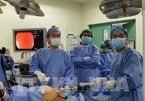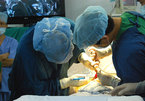 |
|
Doctors at the Vietnam - Germany Friendship Hospital perform the most difficult technique in microtia ear reconstruction. (Photo provided by the hospital)
|
On Monday (Nov. 4), good news from the hospital revealed that after two years of research and technical improvement, the doctors at the hospital’s Plastic Surgery Department have successfully performed MER using self-costal cartilages with only one operation under the support of an endoscopy.
This is one of the most demanding challenges in plastic surgery and the well-known medical facility is the first hospital in Vietnam and one of the very few centres in the world to successfully carry out the most advanced MER, making it a routine operation.
Assoc. Prof., Dr. Nguyen Hong Ha, Head of the Department of Plastic Surgery at the Vietnam - Germany Hospital, said that microtia maybe congenital or acquired due to an accidental loss of ear or burn. Although it is not dangerous to the life of the patient, it can leave a huge negative impact on aesthetics and psychology, especially for children at a pre-school age.
Currently, there are two popular methods of ear reconstruction in the world, in which the use of autologous rib cartilage has been implemented in the past 50 years, but requires at least 2-3 major surgeries with full risks during anesthesia and surgery to build the ear canal, by removing rib cartilage No. 6,7,8 or 9 from rib cage and sculpting into an ear cartilage frame.
The newer method is to shape the coronary ear with an artificial cartilage frame that patients only need one surgery at a very early age as 4-5 years old, in which could bring better aesthetic results than other methods.
“So far, the latter using artificial cartilage has the most advantages. However, the disadvantage is that the artificial cartilage frame is very expensive and has not been covered by health insurance like other high-tech medical supplies such as artificial hip and knee joints. In Vietnam's economic conditions, only a few families are capable of purchasing artificial ear cartilage frames to implement this method for their children,” said Dr. Ha.
In order to help Vietnamese children with congenital microtia, doctors at the hospital have improved the technique and successfully applied the new method of ear reconstruction, using rib cartilage with the help of laparoscopic surgery, which brings the same results as the artificial cartilage method, but the cost is much lower.
“In this technique, we still use the patient's own cartilages to make an ear canal. But instead of having to bury the mold under the skin to wait a year later for the second surgery, the doctors immediately used the superficial temporal flap to cover the cartilage frame, and only with one surgery, the patients are able to get a new ear with almost normal function,” Dr. Ha said.
According to him, the most difficult point of this surgery is how to cover the whole cartilage frame with the superficial temporal flap. Even a small 1-2 mm exposure in the frame can lead to infection or necrosis for the cartilage frame.
Previously, to get the superficial temporal flap, doctors often had to carry out open surgery that would leave a 15-20 cm T-shaped scar on the temple area, causing hair loss or keloids.
Currently, thanks to the application of laparoscopic technique, the hospital’s doctors can get the entire superficial temporal flap without having to make any scars.
The application of laparoscopic not only minimises the smallest aesthetic scars, but also plays an important role in helping enlarge tiny blood vessels like hairs on the screen for close observation, helping to preserve all of these small blood vessels to ensure the superficial temporal flap can be 100% viable.
After two years of technical research and improvement, the doctors at the hospital have successfully performed a range of MER surgeries using self-costal cartilages with the help of laparoscopy. "So far, only one or two of the most advanced centres in the world are able to perform this technique on a regular basis as at our hospital," Dr. Ha said.
Integrating the advantages of both the most popular MER surgical methods in the world has created a new opportunity for patients in Vietnamese conditions, helping them still approach the most modern high-tech techniques in plastic and cosmetic surgery.
From November 9 to 17, the Cosmetic Surgery Department at the hospital will collaborate with the world's leading team of UK experts on MER to offer free examinations and sharing experience in the field as well as face and neck plastic surgeries.
Patients in need can contact the phone number 02438253531 ext 350 (operating 24 hours a day) to register for a free consultation. Nhan Dan

Vietnamese doctors introduce robotic surgery overseas
Doctors from Binh Dan Hospital in Ho Chi Minh City have recently visited the Philippines to perform robot-assisted sleeve gastrectomy operations, showcasing the technique to their local peers.

Recent deaths raise alarm over unlicenced plastic surgery clinics in Vietnam
Two women died last week in HCM City after undergoing plastic surgery.
 Vietnam has become one of a few countries in the world to master microtia ear reconstruction (MER), thanks to efforts from the Hanoi-based Vietnam - Germany Friendship Hospital." itemprop="description" />
Vietnam has become one of a few countries in the world to master microtia ear reconstruction (MER), thanks to efforts from the Hanoi-based Vietnam - Germany Friendship Hospital." itemprop="description" />